oil level YAMAHA YZF-R1 2001 Owners Manual
[x] Cancel search | Manufacturer: YAMAHA, Model Year: 2001, Model line: YZF-R1, Model: YAMAHA YZF-R1 2001Pages: 116, PDF Size: 12.72 MB
Page 13 of 116
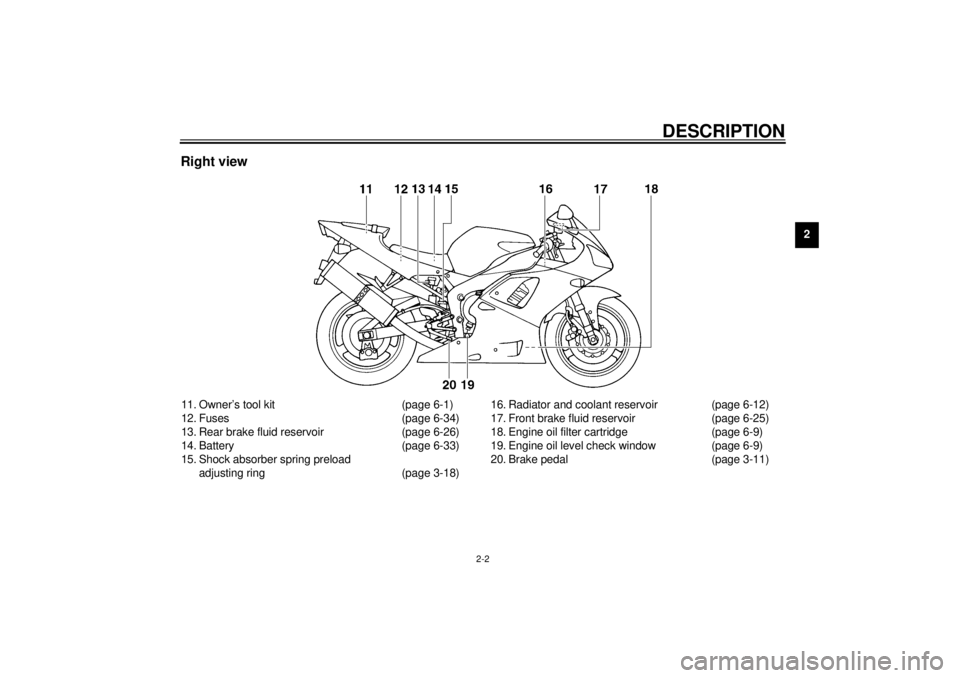
DESCRIPTION
2-2
2
Right view11. Owner’s tool kit (page 6-1)
12. Fuses (page 6-34)
13. Rear brake fluid reservoir (page 6-26)
14. Battery (page 6-33)
15. Shock absorber spring preload
adjusting ring (page 3-18)16. Radiator and coolant reservoir (page 6-12)
17. Front brake fluid reservoir (page 6-25)
18. Engine oil filter cartridge (page 6-9)
19. Engine oil level check window (page 6-9)
20. Brake pedal (page 3-11)
E_5jj.book Page 2 Friday, September 8, 2000 3:33 PM
Page 17 of 116
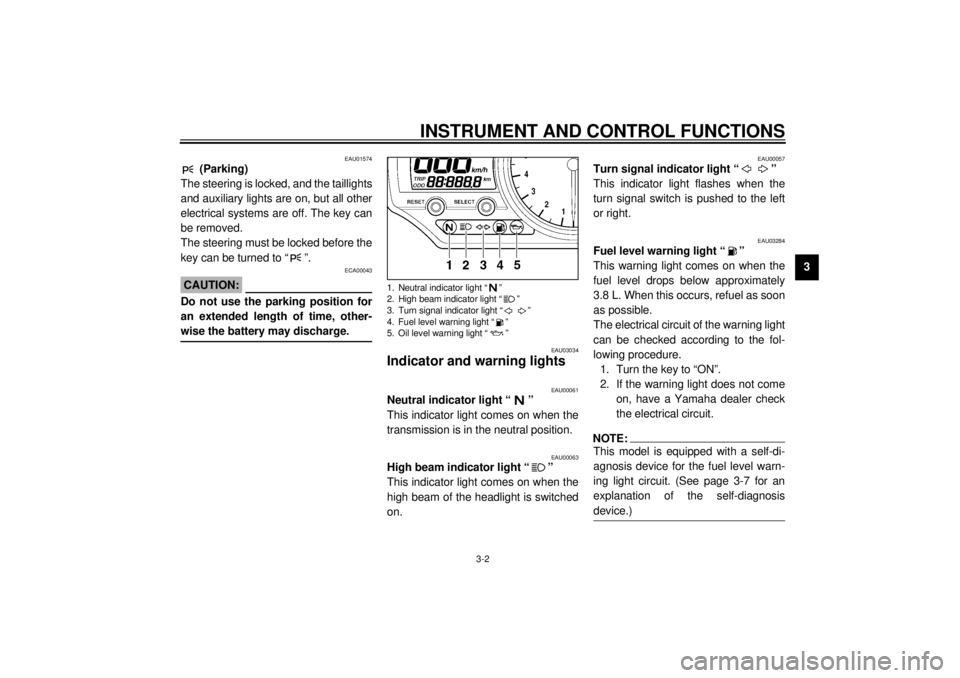
INSTRUMENT AND CONTROL FUNCTIONS
3-2
3
EAU01574
(Parking)
The steering is locked, and the taillights
and auxiliary lights are on, but all other
electrical systems are off. The key can
be removed.
The steering must be locked before the
key can be turned to “ ”.
ECA00043
CAUTION:@ Do not use the parking position for
an extended length of time, other-
wise the battery may discharge. @
EAU03034
Indicator and warning lights
EAU00061
Neutral indicator light “ ”
This indicator light comes on when the
transmission is in the neutral position.
EAU00063
High beam indicator light “ ”
This indicator light comes on when the
high beam of the headlight is switched
on.
EAU00057
Turn signal indicator light “ ”
This indicator light flashes when the
turn signal switch is pushed to the left
or right.
EAU03284
Fuel level warning light “ ”
This warning light comes on when the
fuel level drops below approximately
3.8 L. When this occurs, refuel as soon
as possible.
The electrical circuit of the warning light
can be checked according to the fol-
lowing procedure.
1. Turn the key to “ON”.
2. If the warning light does not come
on, have a Yamaha dealer check
the electrical circuit.NOTE:@ This model is equipped with a self-di-
agnosis device for the fuel level warn-
ing light circuit. (See page 3-7 for an
explanation of the self-diagnosis
device.) @
1. Neutral indicator light “ ”
2. High beam indicator light “ ”
3. Turn signal indicator light “ ”
4. Fuel level warning light “ ”
5. Oil level warning light “ ”
E_5jj.book Page 2 Friday, September 8, 2000 3:33 PM
Page 18 of 116
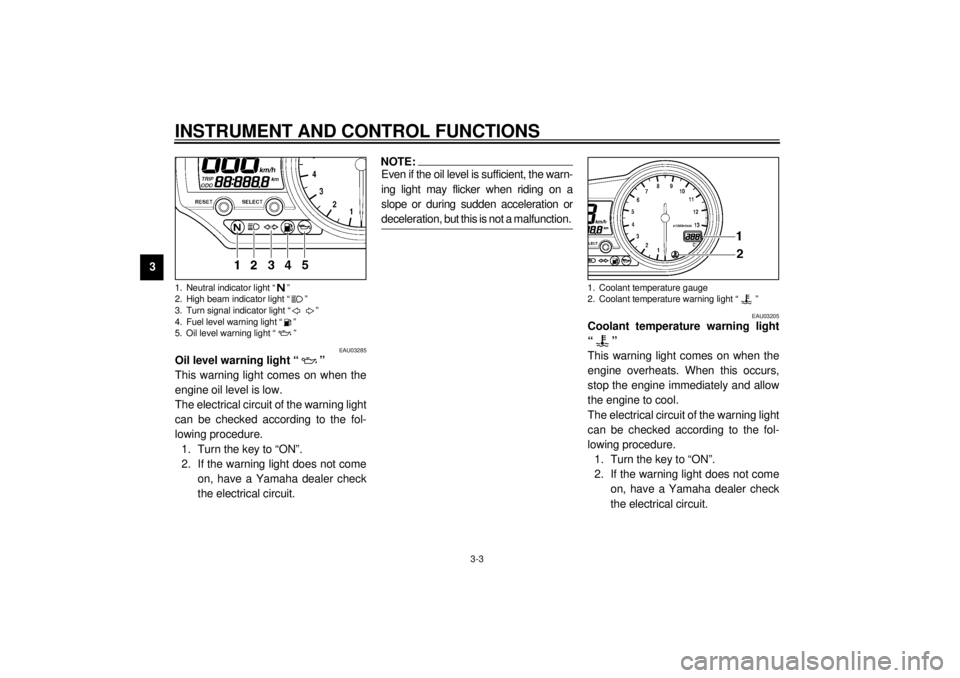
INSTRUMENT AND CONTROL FUNCTIONS
3-3
3
EAU03285
Oil level warning light “ ”
This warning light comes on when the
engine oil level is low.
The electrical circuit of the warning light
can be checked according to the fol-
lowing procedure.
1. Turn the key to “ON”.
2. If the warning light does not come
on, have a Yamaha dealer check
the electrical circuit.
NOTE:@ Even if the oil level is sufficient, the warn-
ing light may flicker when riding on a
slope or during sudden acceleration or
deceleration, but this is not a malfunction. @
EAU03205
Coolant temperature warning light
“”
This warning light comes on when the
engine overheats. When this occurs,
stop the engine immediately and allow
the engine to cool.
The electrical circuit of the warning light
can be checked according to the fol-
lowing procedure.
1. Turn the key to “ON”.
2. If the warning light does not come
on, have a Yamaha dealer check
the electrical circuit.
1. Neutral indicator light “ ”
2. High beam indicator light “ ”
3. Turn signal indicator light “ ”
4. Fuel level warning light “ ”
5. Oil level warning light “ ”
1. Coolant temperature gauge
2. Coolant temperature warning light “ ”
E_5jj.book Page 3 Friday, September 8, 2000 3:33 PM
Page 42 of 116

4-1
4
EAU01114
4-PRE-OPERATION CHECKSThe condition of a vehicle is the owner’s responsibility. Vital components can start to deteriorate quickly and unexpectedly,
even if the vehicle remains unused (for example, as a result of exposure to the elements). Any damage, fluid leakage or loss
of tire air pressure could have serious consequences. Therefore, it is very important, in addition to a thorough visual inspec-
tion, to check the following points before each ride.
EAU03439
Pre-operation check list
ITEM CHECKS PAGE
Fuel• Check fuel level in fuel tank.
• Refuel if necessary.
• Check fuel line for leakage.3-12
Engine oil• Check oil level in engine.
• If necessary, add recommended oil to specified level.
• Check vehicle for oil leakage.6-9
Coolant• Check coolant level in reservoir.
• If necessary, add recommended coolant to specified level.
• Check cooling system for leakage.6-12–6-13
Front brake• Check operation.
• If soft or spongy, have Yamaha dealer bleed hydraulic system.
• Check fluid level in reservoir.
• If necessary, add recommended brake fluid to specified level.
• Check hydraulic system for leakage.6-24–6-26
Rear brake• Check operation.
• If soft or spongy, have Yamaha dealer bleed hydraulic system.
• Check fluid level in reservoir.
• If necessary, add recommended brake fluid to specified level.
• Check hydraulic system for leakage.6-23–6-26
Clutch• Check operation.
• Lubricate cable if necessary.
• Check lever free play.
• Adjust if necessary.6-22–6-23
Throttle grip• Make sure that operation is smooth.
• Lubricate throttle grip, housing and cables if necessary.
• Check free play.
• If necessary, have Yamaha dealer make adjustment.6-18, 6-29
E_5jj.book Page 1 Friday, September 8, 2000 3:33 PM
Page 47 of 116
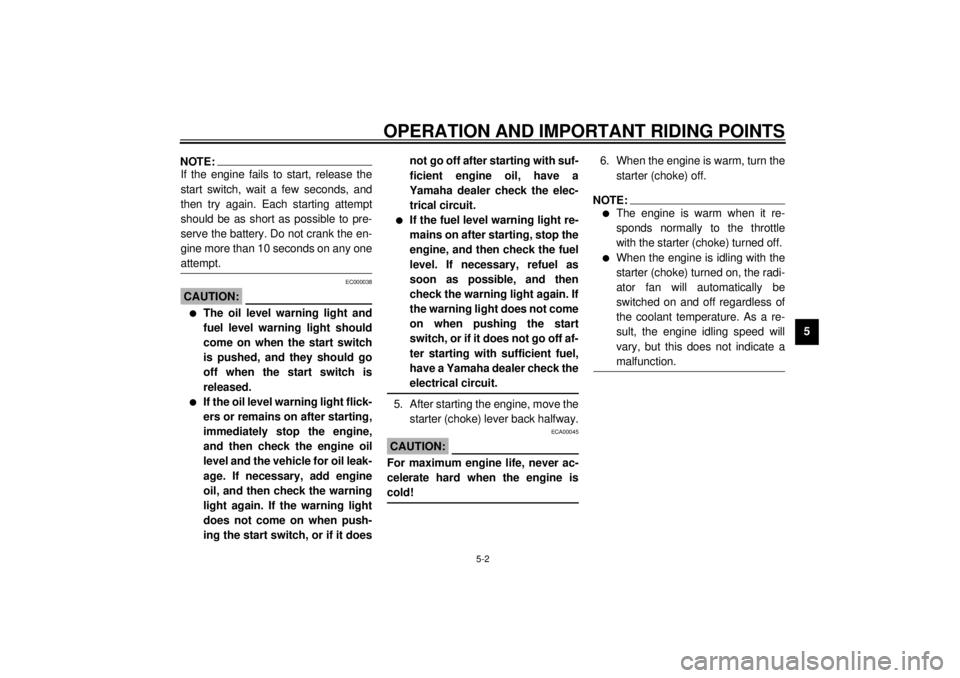
OPERATION AND IMPORTANT RIDING POINTS
5-2
5
NOTE:@ If the engine fails to start, release the
start switch, wait a few seconds, and
then try again. Each starting attempt
should be as short as possible to pre-
serve the battery. Do not crank the en-
gine more than 10 seconds on any one
attempt. @
EC000038
CAUTION:@ l
The oil level warning light and
fuel level warning light should
come on when the start switch
is pushed, and they should go
off when the start switch is
released.
l
If the oil level warning light flick-
ers or remains on after starting,
immediately stop the engine,
and then check the engine oil
level and the vehicle for oil leak-
age. If necessary, add engine
oil, and then check the warning
light again. If the warning light
does not come on when push-
ing the start switch, or if it doesnot go off after starting with suf-
ficient engine oil, have a
Yamaha dealer check the elec-
trical circuit.
l
If the fuel level warning light re-
mains on after starting, stop the
engine, and then check the fuel
level. If necessary, refuel as
soon as possible, and then
check the warning light again. If
the warning light does not come
on when pushing the start
switch, or if it does not go off af-
ter starting with sufficient fuel,
have a Yamaha dealer check the
electrical circuit.
@5. After starting the engine, move the
starter (choke) lever back halfway.
ECA00045
CAUTION:@ For maximum engine life, never ac-
celerate hard when the engine is
cold! @
6. When the engine is warm, turn the
starter (choke) off.NOTE:@ l
The engine is warm when it re-
sponds normally to the throttle
with the starter (choke) turned off.
l
When the engine is idling with the
starter (choke) turned on, the radi-
ator fan will automatically be
switched on and off regardless of
the coolant temperature. As a re-
sult, the engine idling speed will
vary, but this does not indicate a
malfunction.
@
E_5jj.book Page 2 Friday, September 8, 2000 3:33 PM
Page 51 of 116
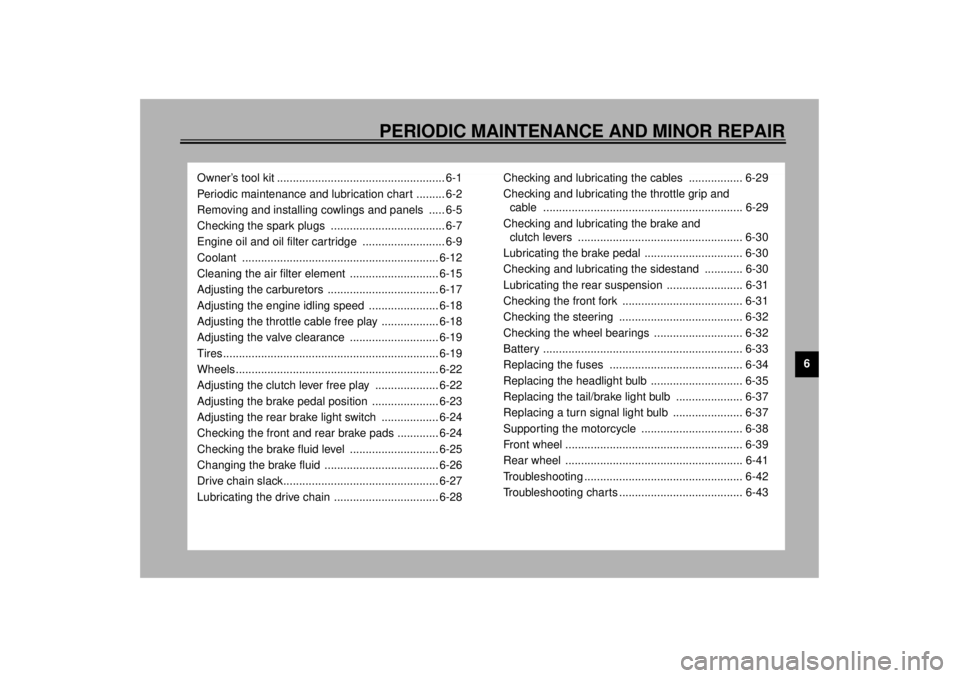
6
PERIODIC MAINTENANCE AND MINOR REPAIR
Owner’s tool kit ..................................................... 6-1
Periodic maintenance and lubrication chart ......... 6-2
Removing and installing cowlings and panels ..... 6-5
Checking the spark plugs .................................... 6-7
Engine oil and oil filter cartridge .......................... 6-9
Coolant .............................................................. 6-12
Cleaning the air filter element ............................ 6-15
Adjusting the carburetors ................................... 6-17
Adjusting the engine idling speed ...................... 6-18
Adjusting the throttle cable free play .................. 6-18
Adjusting the valve clearance ............................ 6-19
Tires .................................................................... 6-19
Wheels ................................................................ 6-22
Adjusting the clutch lever free play .................... 6-22
Adjusting the brake pedal position ..................... 6-23
Adjusting the rear brake light switch .................. 6-24
Checking the front and rear brake pads ............. 6-24
Checking the brake fluid level ............................ 6-25
Changing the brake fluid .................................... 6-26
Drive chain slack................................................. 6-27
Lubricating the drive chain ................................. 6-28Checking and lubricating the cables ................. 6-29
Checking and lubricating the throttle grip and
cable ............................................................... 6-29
Checking and lubricating the brake and
clutch levers .................................................... 6-30
Lubricating the brake pedal ............................... 6-30
Checking and lubricating the sidestand ............ 6-30
Lubricating the rear suspension ........................ 6-31
Checking the front fork ...................................... 6-31
Checking the steering ....................................... 6-32
Checking the wheel bearings ............................ 6-32
Battery ............................................................... 6-33
Replacing the fuses .......................................... 6-34
Replacing the headlight bulb ............................. 6-35
Replacing the tail/brake light bulb ..................... 6-37
Replacing a turn signal light bulb ...................... 6-37
Supporting the motorcycle ................................ 6-38
Front wheel ........................................................ 6-39
Rear wheel ........................................................ 6-41
Troubleshooting .................................................. 6-42
Troubleshooting charts ....................................... 6-43
E_5jj.book Page 1 Friday, September 8, 2000 3:33 PM
Page 60 of 116
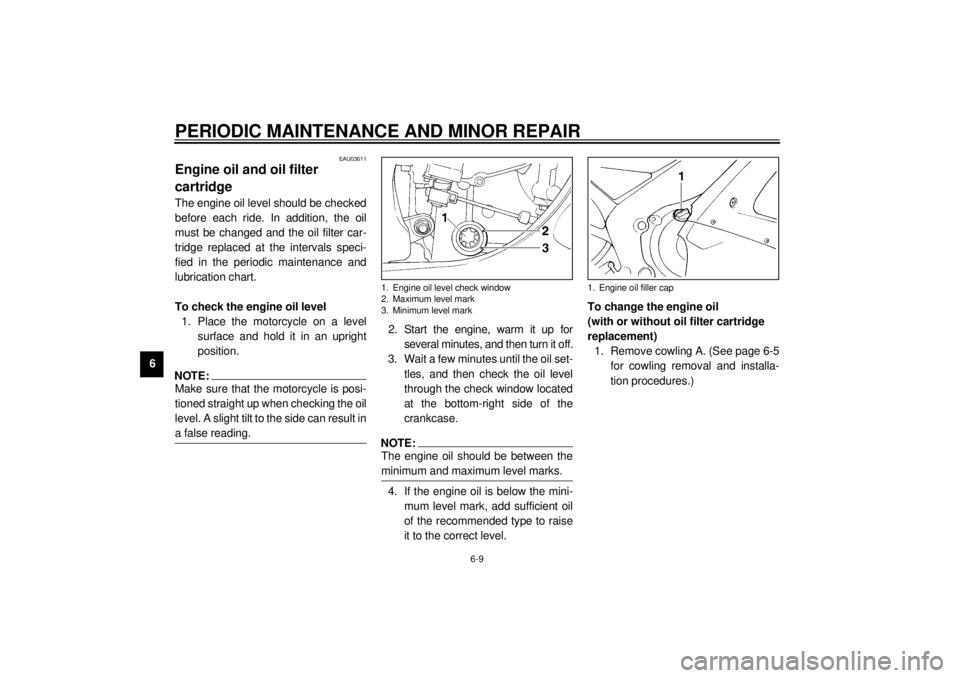
PERIODIC MAINTENANCE AND MINOR REPAIR
6-9
6
EAU03611
Engine oil and oil filter
cartridge The engine oil level should be checked
before each ride. In addition, the oil
must be changed and the oil filter car-
tridge replaced at the intervals speci-
fied in the periodic maintenance and
lubrication chart.
To check the engine oil level
1. Place the motorcycle on a level
surface and hold it in an upright
position.NOTE:@ Make sure that the motorcycle is posi-
tioned straight up when checking the oil
level. A slight tilt to the side can result in
a false reading. @
2. Start the engine, warm it up for
several minutes, and then turn it off.
3. Wait a few minutes until the oil set-
tles, and then check the oil level
through the check window located
at the bottom-right side of the
crankcase.NOTE:@ The engine oil should be between the
minimum and maximum level marks. @4. If the engine oil is below the mini-
mum level mark, add sufficient oil
of the recommended type to raise
it to the correct level.To change the engine oil
(with or without oil filter cartridge
replacement)
1. Remove cowling A. (See page 6-5
for cowling removal and installa-
tion procedures.)1. Engine oil level check window
2. Maximum level mark
3. Minimum level mark
1. Engine oil filler cap
E_5jj.book Page 9 Friday, September 8, 2000 3:33 PM
Page 62 of 116
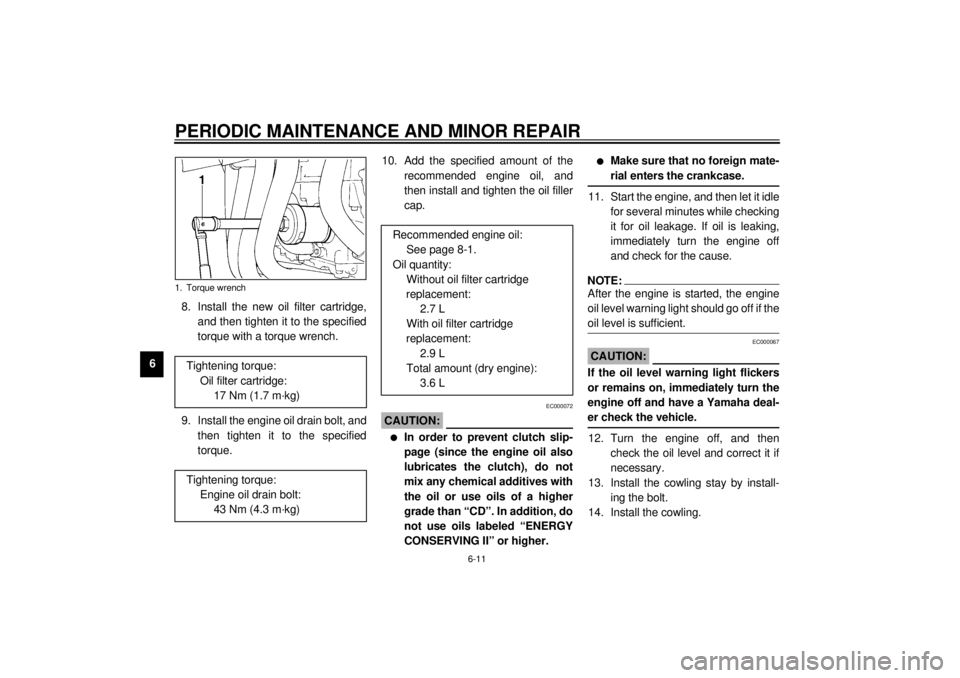
PERIODIC MAINTENANCE AND MINOR REPAIR
6-11
68. Install the new oil filter cartridge,
and then tighten it to the specified
torque with a torque wrench.
9. Install the engine oil drain bolt, and
then tighten it to the specified
torque.10. Add the specified amount of the
recommended engine oil, and
then install and tighten the oil filler
cap.
EC000072
CAUTION:@ l
In order to prevent clutch slip-
page (since the engine oil also
lubricates the clutch), do not
mix any chemical additives with
the oil or use oils of a higher
grade than “CD”. In addition, do
not use oils labeled “ENERGY
CONSERVING II” or higher.
l
Make sure that no foreign mate-
rial enters the crankcase.
@11. Start the engine, and then let it idle
for several minutes while checking
it for oil leakage. If oil is leaking,
immediately turn the engine off
and check for the cause.NOTE:@ After the engine is started, the engine
oil level warning light should go off if the
oil level is sufficient. @
EC000067
CAUTION:@ If the oil level warning light flickers
or remains on, immediately turn the
engine off and have a Yamaha deal-
er check the vehicle. @12. Turn the engine off, and then
check the oil level and correct it if
necessary.
13. Install the cowling stay by install-
ing the bolt.
14. Install the cowling.
1. Torque wrenchTightening torque:
Oil filter cartridge:
17 Nm (1.7 m·kg)
Tightening torque:
Engine oil drain bolt:
43 Nm (4.3 m·kg)
Recommended engine oil:
See page 8-1.
Oil quantity:
Without oil filter cartridge
replacement:
2.7 L
With oil filter cartridge
replacement:
2.9 L
Total amount (dry engine):
3.6 L
E_5jj.book Page 11 Friday, September 8, 2000 3:33 PM
Page 77 of 116
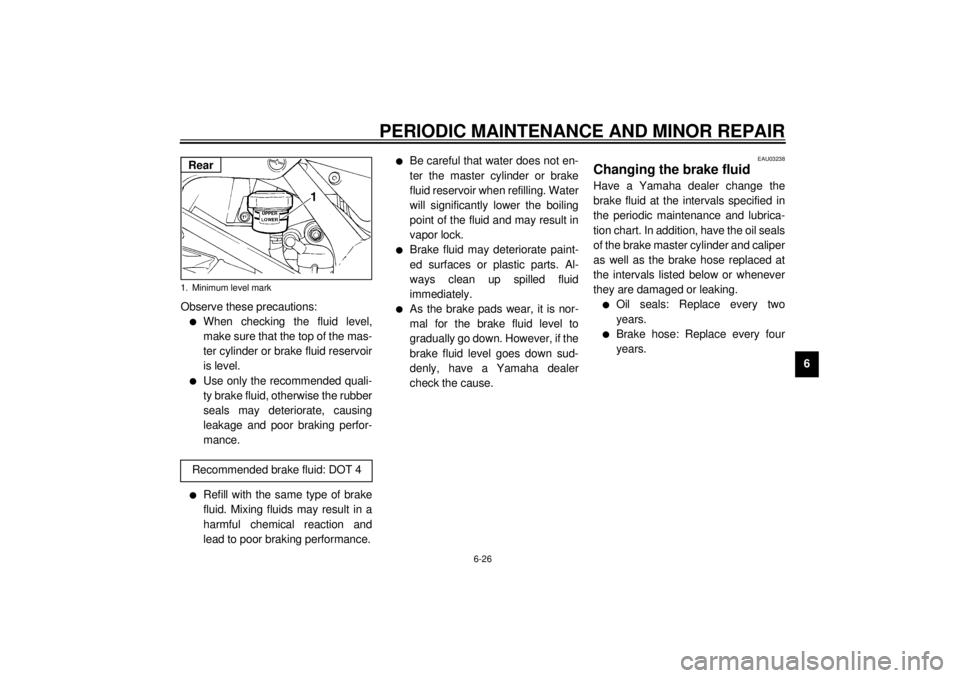
PERIODIC MAINTENANCE AND MINOR REPAIR
6-26
6 Observe these precautions:
l
When checking the fluid level,
make sure that the top of the mas-
ter cylinder or brake fluid reservoir
is level.
l
Use only the recommended quali-
ty brake fluid, otherwise the rubber
seals may deteriorate, causing
leakage and poor braking perfor-
mance.
l
Refill with the same type of brake
fluid. Mixing fluids may result in a
harmful chemical reaction and
lead to poor braking performance.
l
Be careful that water does not en-
ter the master cylinder or brake
fluid reservoir when refilling. Water
will significantly lower the boiling
point of the fluid and may result in
vapor lock.
l
Brake fluid may deteriorate paint-
ed surfaces or plastic parts. Al-
ways clean up spilled fluid
immediately.
l
As the brake pads wear, it is nor-
mal for the brake fluid level to
gradually go down. However, if the
brake fluid level goes down sud-
denly, have a Yamaha dealer
check the cause.
EAU03238
Changing the brake fluid Have a Yamaha dealer change the
brake fluid at the intervals specified in
the periodic maintenance and lubrica-
tion chart. In addition, have the oil seals
of the brake master cylinder and caliper
as well as the brake hose replaced at
the intervals listed below or whenever
they are damaged or leaking.l
Oil seals: Replace every two
years.
l
Brake hose: Replace every four
years.
1. Minimum level mark
Recommended brake fluid: DOT 4RearRear
E_5jj.book Page 26 Friday, September 8, 2000 3:33 PM
Page 82 of 116
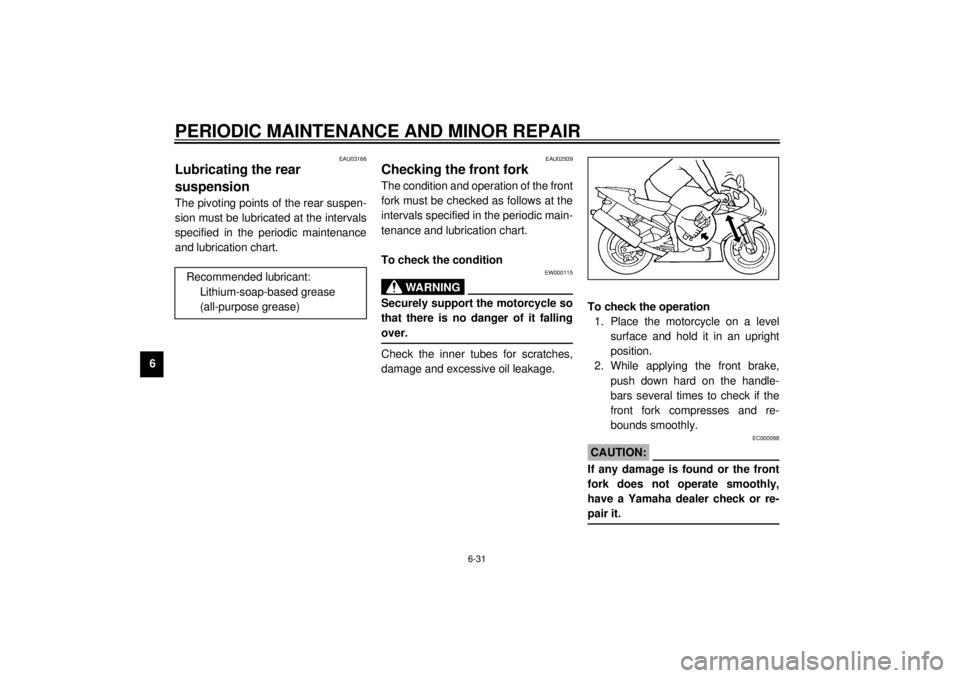
PERIODIC MAINTENANCE AND MINOR REPAIR
6-31
6
EAU03166
Lubricating the rear
suspension The pivoting points of the rear suspen-
sion must be lubricated at the intervals
specified in the periodic maintenance
and lubrication chart.
EAU02939
Checking the front fork The condition and operation of the front
fork must be checked as follows at the
intervals specified in the periodic main-
tenance and lubrication chart.
To check the condition
EW000115
WARNING
@ Securely support the motorcycle so
that there is no danger of it falling
over. @Check the inner tubes for scratches,
damage and excessive oil leakage.To check the operation
1. Place the motorcycle on a level
surface and hold it in an upright
position.
2. While applying the front brake,
push down hard on the handle-
bars several times to check if the
front fork compresses and re-
bounds smoothly.
EC000098
CAUTION:@ If any damage is found or the front
fork does not operate smoothly,
have a Yamaha dealer check or re-
pair it. @
Recommended lubricant:
Lithium-soap-based grease
(all-purpose grease)
E_5jj.book Page 31 Friday, September 8, 2000 3:33 PM